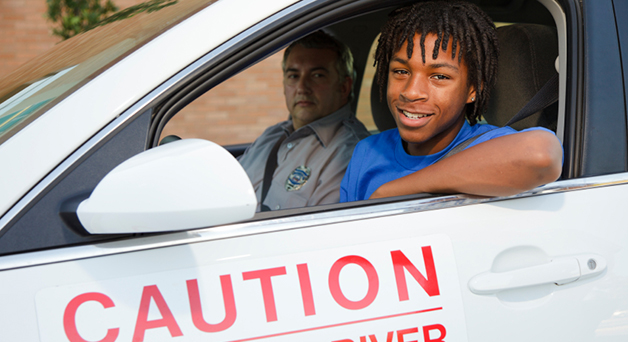Youth who receive special education services under the Individuals with Disabilities Education Act (IDEA 2004) and especially young adults of transition age, should be involved in planning for life after high school as early as possible and no later than age 16. Transition services should stem from the individual youth’s needs and strengths, ensuring that planning takes into account his or her interests, preferences, and desires for the future.
Driver Safety

Teen motor vehicle crashes can be prevented, and statistics indicate that the annual number of drivers aged 15 to 17 years involved in fatal crashes decreased 48 percent from 2005 to 2014 (Governors Highway Traffic Safety Association (GHSA), 2016). While this is promising, motor vehicle crashes continue to be the leading cause of death among teens; per mile driven, teen drivers ages 16 to 19 are nearly three times more likely than older drivers to be involved in a fatal crash (Insurance Institute for Highway Safety (IIHS), 2017).
Many factors influence teens' crash risk and likelihood for injury or death. These include driving ability, developmental factors, behavioral factors, personality factors, demographics, the perceived environment, and the driving environment (Shope & Bingham, 2008). For example, due to inexperience, teen drivers are more likely to take unnecessary risks including driving without a seatbelt, driving while distracted (e.g., texting, eating), and speeding. Situational factors such as driving at night, driving under the influence, and driving with other teenage passengers also place teens at higher risk (IIHS, 2017).2Prevention efforts to minimize the risk of deaths, injuries, and crashes related to teen driving need to be comprehensive and take into account the complex factors that influence driving. Research has indicated that strategies such as stronger seat belt laws and graduated driver licensing (GDL) have been successful in improving teen driver safety (Masten et. al., 2015).
References
Centers for Disease Control and Prevention. National Center for Injury Prevention and Control. (2009). Web-based injury statistics query and reporting system (WISQARS). Retrieved from http://www.cdc.gov/injury/wisqars/index.html
Centers for Disease Control and Prevention. Division of Unintentional Injury Prevention, National Center for Injury Prevention and Control. (2010). Drivers Aged 16 or 17 Years Involved in Fatal Crashes—United States, 2004–2008. Morbidity and Mortality Weekly Report (MMWR), 59(41), 1329-1334. Retrieved from http://www.cdc.gov/mmwr/preview/mmwrhtml/mm5941a2.htm?s_cid=mm5941a2_e
Insurance Institute for Highway Safety. (2017). Fatality Facts: Teenagers (Rep.). Retrieved May 30, 2018 from http://www.iihs.org/iihs/topics/t/teenagers/fatalityfacts/teenager
Fischer, P. (2016). Mission Not Accomplished: Teen Driver Safety, the Next Chapter (Rep.). Washington, DC: Governors Highway Satey Association. Retrieved from https://www.ghsa.org/sites/default/files/2016-12/FINAL_TeenReport16.pdf
Masten, S. V., Thomas, F. D., Korbelak, K. T., Peck, R. C., & Blomberg, R. D. (2015, November). Meta-analysis of graduated driver licensing laws. (Report No. DOT HS 812 211). Washington, DC: National Highway Traffic Safety Administration. Retrieved from https://www.nhtsa.gov/sites/nhtsa.dot.gov/files/812211-metaanalysisgdlla...
National Highway Traffic Safety Administration. Office of Behavioral Safety Research. (2008). Teen driver crashes: A report to Congress. Washington, DC: Compton, R. P., & Ellison-Potter., P.
Shope, J. T., & Bingham, C. R. (2008).Teen driving: Motor-vehicle crashes and factors that contribute. American Journal of Prevention Medicine, 35(3S, S261-S271).
Other Resources on this Topic
Agencies
Announcements
Collaboration Profiles
Data Sources
Departments
Feature Articles
Publications
Resources
Technical Assistance
Tools & Guides
Videos & Podcasts
Websites
Youth Topics
Youth Briefs
Research links early leadership with increased self-efficacy and suggests that leadership can help youth to develop decision making and interpersonal skills that support successes in the workforce and adulthood. In addition, young leaders tend to be more involved in their communities, and have lower dropout rates than their peers. Youth leaders also show considerable benefits for their communities, providing valuable insight into the needs and interests of young people
Statistics reflecting the number of youth suffering from mental health, substance abuse, and co-occurring disorders highlight the necessity for schools, families, support staff, and communities to work together to develop targeted, coordinated, and comprehensive transition plans for young people with a history of mental health needs and/or substance abuse.
Nearly 30,000 youth aged out of foster care in Fiscal Year 2009, which represents nine percent of the young people involved in the foster care system that year. This transition can be challenging for youth, especially youth who have grown up in the child welfare system.
Research has demonstrated that as many as one in five children/youth have a diagnosable mental health disorder. Read about how coordination between public service agencies can improve treatment for these youth.
Civic engagement has the potential to empower young adults, increase their self-determination, and give them the skills and self-confidence they need to enter the workforce. Read about one youth’s experience in AmeriCorps National Civilian Community Corps (NCCC).
Nearly two out of three crash deaths involving 16-year-old drivers happen when the driver has one or more teen passengers.






